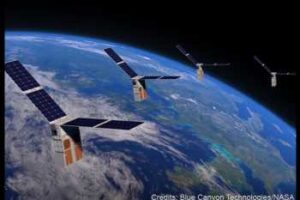NASA Sending Satellites Into Orbit To Test Autonomous Command Capability

NASA has announced that this month, it will be sending multiple cluster satellites into orbit around Earth to see if they are able to cooperate on their own, without real-time updates from mission control.
The new mission is to test the autonomous command capability of small satellites for the future of deep space missions, where more complex and autonomous spacecraft will be essential, NASA said.
Once launched, the four six-unit (6U)-sized CubeSats will fly in two different formations to test several technologies paving the way towards a future where clusters of satellites can cooperate with astronauts to do science in deep space.
This mission, called Starling, will last at least six months, positioning the spacecraft about 355 miles above Earth and spaced about 40 miles apart.
“Starling, and the capabilities it brings for autonomous command and control for swarms of small spacecraft, will enhance NASA’s abilities for future science and exploration missions,” said Roger Hunter, program manager for NASA’s Small Spacecraft Technology program at NASA’s Ames Research Center in California’s Silicon Valley. “The mission represents a significant step forward.”
Starling is looking to create a cluster of small satellites that can function as an autonomous community, capable of responding to their environment and completing tasks as a team.
Each CubeSat also has its own “star tracker” sensors onboard, normally used so that a satellite can keep track of its own orientation in space, much like sailors using the stars to navigate at night.
Source: Read Full Article
